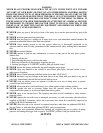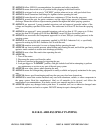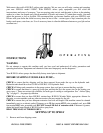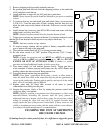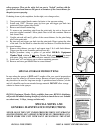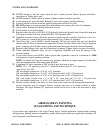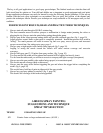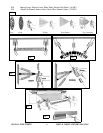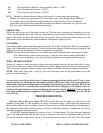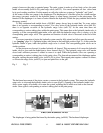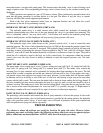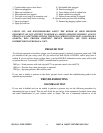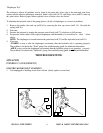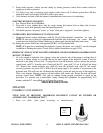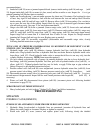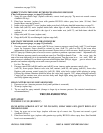
H.E.R.O. INDUSTRIES 1100C & 1100NC OWNERS MANUAL
11
.013 Fine ground Gloss Enamels, and good quality Stains. ( 23 OZ. )
.011 Clear Varnishes and Lacquers. ( 15 OZ. )
.009 Clear Varnishes and Lacquers. ( 10 OZ. )
NOT: The above volumes achieved with gun wide open for 1 minute and pump spraying at
2000psi. All volumes are approximate. To test worn tips, spray water through the tip at 2000 psi.
for 1 minute. Spray into bucket and weigh amount (less weight of bucket). If it is substantially
greater than what is listed above, then the tip should be discarded or reclassified. As a tip wears, the
hole gets larger and the fan pattern becomes narrower.
ORIFICE SIZE
All tips are rated by the size of the orifice or bore size. The bore size is measured in thousandths of an inch
( .018 = 18 thousandths of an inch ). The size of tip required is based on the consistency of the material to be
sprayed. The thicker the paint, the larger the tip size required. Always consult the product label or ask the
paint retailer for the manufacturer's recommendations with regard to proper tip sizes.
FAN WIDTH
Fan width or pattern width is determined by the spray tip's "fan width" classification. This size is measured in
inches, and is determined when spraying 12 inches from the spray surface. Various methods of noting the fan
widths are used by tip manufacturers. Ask your distributor for assistance.
NOTE: Two tips having the same tip size, but different fan widths will deliver the same amount of paint
over a different area (wider or narrower strip). A spray tip with a narrow pattern width makes it
easy to spray in tight places. Use only good quality, high-pressure tungsten carbide spray tips.
SPRAY TIP REPLACEMENT
During use, especially with Latex paint, high pressure and material abrasion will cause the orifice to grow
larger. As the orifice grows larger, the fan width grows smaller. Replace tips before they become excessively
worn. Worn tips waste paint, cause overspray, make cutting in difficult, and decrease sprayer performance.
NOTE: When using Latex paint, a spray tip will wear at the rate of one size for approximately every 100
gallons of material sprayed.
An excessively worn tip can be the cause of apparent operating problems with the unit. If a tip is worn
past the aperture size which the unit can support, pulsation will become evident in the spray fan/pattern.
Added strain is placed on the Diaphragm as it attempts to keep the spray pressure consistent. When the tip
wears beyond .031, its is releasing more material than the unit is bringing in. The natural reserve of
product in the paint chamber is reduced and harm to the membrane begins. ALWAYS check your tips for
wear when trouble shooting the equipment. The 1100NC can support up to a maximum of a one .026 tip
or two 017 tips.
TROUBLESHOOTING
Hydraulic Energy Regulated Output (H.E.R.O.) is more than just our name, it is the bases for the
operation of the pump. It is the regulation or control, of hydraulic energy, which allows the equipment to
build and then deliver or have an output of pressure. Once you have a basic understanding of the operation of
the equipment and the effect created in one area and how it will effect operation in another area, you will be
better able to diagnose and make repairs.
All H.E.R.O. diaphragm pumps are made up of two (2) distinct pumps. The first, and most important
pump is the hydraulic pump. The hydraulic system is made up of two valves, the hydraulic intake valve (ref#
59) and the hydraulic outgo valve, known as the hydraulic pressure control valve (ref # 70). The second



